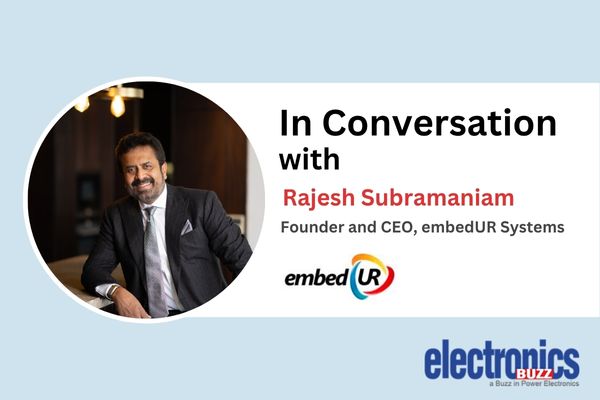In an interview with Electronics Buzz, Rajesh Subramaniam, Founder and CEO of embedUR Systems, shared insights on the evolution of embedded technology, India’s strategic role in Edge AI, and the company’s ambitious ₹500 crore investment plan. Highlighting opportunities across healthcare and industrial IoT, Rajesh emphasized embedUR’s commitment to innovation, talent development, and partnerships that are accelerating the future of intelligent, scalable embedded solutions.
Read the full interview here:
Eb: With over three decades of experience in embedded technology, how have you seen the industry evolve, and what excites you most about its current trajectory—especially in the context of AI and IoT?
Rajesh: Over the past thirty years, embedded systems have evolved from static, hardware-driven components to dynamic, software-defined ecosystems. Today, we’re witnessing a transformative shift as embedded platforms become intelligent, interconnected, and autonomous—powered by the convergence of AI, edge computing, and IoT. What excites me most is the democratization of intelligence—where even the most resource-constrained devices can support AI capabilities. This is made possible by advancements in low-power processors, optimized AI models, and efficient edge inference. At embedUR, we’re at the forefront of this transformation, enabling smarter decision-making at the edge. Our deep expertise across device, connectivity, and management layers uniquely positions us to build solutions that are not only intelligent but also scalable, secure, and efficient across industries.
Eb: embedUR has played a critical role in accelerating time-to-market for global tech giants. Can you share a standout example of how your team’s innovation significantly impacted a partner’s product or market success?
Rajesh: One notable example is our collaboration with a leading global networking company, where we helped reduce the launch time of their IoT-enabled platform by over six months. We delivered end-to-end support—from firmware development to cloud integration, leveraging our proprietary IP and domain-specific expertise. Our comprehensive approach ensured seamless integration and scalability, allowing the customer to gain a competitive edge in the market. This success reflects our broader go-to-market (GTM) strategy, anchored in customer-centric innovation, strategic partnerships with silicon vendors, and deep investments in Edge AI technologies. Differentiators like ModelNova and close-to-silicon enablement enable us to deliver commercialization-ready solutions faster than anyone else.
Eb: India is emerging as a pivotal player in the global tech ecosystem. What specific advantages do you see in India becoming a hub for embedded systems development, and how is embedUR positioned to lead that transformation?
Rajesh: India is uniquely positioned to become a global hub for embedded systems development, thanks to its deep talent pool, cost advantages, and rapidly advancing digital infrastructure. As sectors like smart cities, healthcare, and industrial automation increasingly rely on embedded intelligence, India has the strategic potential to lead the global value chain. However, to fully realize this potential, we must address the critical skills gap. Talent development must go beyond software—it must integrate hardware design, system integration, real-time analytics, and secure coding. With IoT, AI, and edge computing gaining momentum, embedding these competencies into upskilling initiatives is key. By aligning education with these evolving demands, India can deliver scalable, affordable, and secure embedded solutions to the world.
At embedUR, we don’t see India as just a delivery center—we’re building it as a center of innovation. Our investments here support R&D, co-creation with academic institutions, and the development of vertical-specific Centers of Excellence. We’re also focused on talent transformation—bridging skill gaps in hardware design, AI integration, and cybersecurity—so that Indian engineers can drive the next wave of embedded innovation both locally and globally.
Eb: Your strategic investment of ₹500 crore and plans to expand to 2,000+ employees by 2029 mark a bold commitment. Could you elaborate on the roadmap and the key areas of growth you’re targeting?
Rajesh: This investment underscores our long-term vision for India’s role in the embedded and Edge AI revolution. Our roadmap includes:
- Expanding engineering capacity in AI, edge computing, embedded security, and networking stacks
- Establishing state-of-the-art R&D centers and industry-academic innovation labs
- Launching Centers of Excellence in high-impact areas like healthcare and industrial IoT
- Deepening our focus on workforce development with structured upskilling programs in edge architecture, real-time analytics, AI/ML on MCUs, and secure firmware design
All of this is supported by our GTM initiatives, including partnerships with leading silicon players and platforms like ModelNova that accelerate solution development and deployment.
Eb: With increasing demand for smart, connected, and cost-effective devices, how is embedUR leveraging partnerships with semiconductor players to create accessible AI chip solutions tailored for the Indian and APAC markets?
Rajesh: We’re working closely with global silicon leaders to co-develop AI-capable SoCs optimized for performance, cost, and power efficiency. These efforts are particularly impactful for emerging use cases in smart homes, industrial automation, and portable healthcare devices. Our teams contribute to early SDKs, toolchains, and reference implementations, enabling highly efficient edge inference on compact hardware. By embedding intelligence at the silicon level, we reduce cloud dependency—which is vital for low-connectivity regions—and enable real-time responsiveness. Through platforms like ModelNova, we further simplify adoption by providing ready-to-deploy AI models and toolkits tailored to these chipsets.
Eb: Given embedUR’s expertise across healthcare, industrial, automotive, and consumer tech, where do you see the biggest opportunity for embedded innovation in the next five years—and how are you preparing for it?
Rajesh: Healthcare and industrial IoT represent the most compelling opportunities. In healthcare, AI-powered diagnostics, remote patient monitoring, and connected medical devices are transforming care delivery. In industrial IoT, predictive maintenance, energy optimization, and smart factories are becoming critical to operational efficiency. To address these opportunities, we’re building modular, scalable edge architectures that adapt quickly to evolving customer needs. Security, compliance, and interoperability are built-in from day one. We’re also doubling down on AI enablement—working closely with silicon and ecosystem partners to bring advanced functionality to cost-effective devices that can serve both developed and underserved markets.













